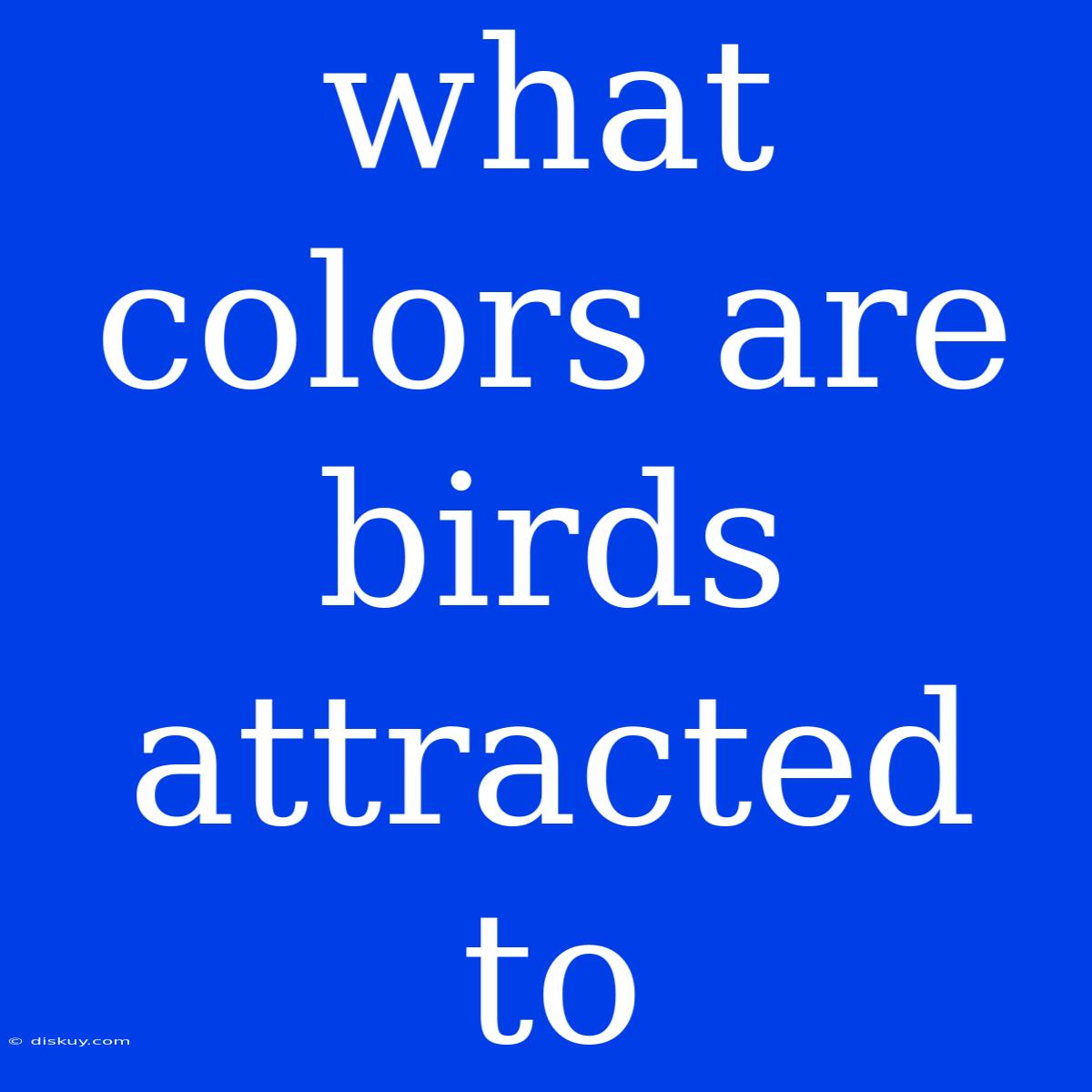What Colors Are Birds Attracted To? Unlocking the Secrets of Avian Color Preferences
What colors do birds see, and which ones are they most drawn to? Birds possess a unique visual system, enabling them to perceive a wider spectrum of colors than humans. This remarkable ability plays a crucial role in their survival, guiding their foraging, mating, and navigation.
Editor Note: Understanding bird color preferences can be valuable for bird watchers, backyard enthusiasts, and conservation efforts. This guide delves into the science behind avian color perception and explores the colors that attract birds most effectively.
Why is this topic important? Birds rely on visual cues for a myriad of essential tasks. Understanding which colors attract them can aid in designing bird feeders, landscaping gardens to attract specific species, and even improving conservation strategies.
Analysis: This article explores the scientific research on bird color perception and analyzes various studies to identify the most attractive colors for different bird species. It examines the role of color in attracting birds to feeders, landscapes, and nesting sites.
Key Takeaways:
| Color | Bird Attraction | Significance |
|---|---|---|
| Red | Strong attraction | High visibility, associated with ripe fruit and berries |
| Yellow | Moderate attraction | Mimics insects and some flowers |
| Green | Moderate attraction | Blends with foliage, less conspicuous |
| Blue | Moderate attraction | Associated with water, less common in nature |
| Purple | Weak attraction | Less common in nature, may be perceived as threat |
Color Perception in Birds
Birds have a unique visual system with four types of cone cells in their eyes, allowing them to perceive ultraviolet light, a color invisible to humans. This expanded color spectrum impacts their perception of various colors, including:
- Red: Birds perceive red as a bright, highly visible color, making it a strong attractant, especially for frugivores.
- Yellow: Yellow is easily visible against green foliage, attracting insects and nectar-feeding birds.
- Green: Green blends well with foliage, making it less conspicuous for birds seeking camouflage.
- Blue: Blue is less common in nature, making it an effective attractant for water-loving birds.
- Purple: Purple is less common in the bird's natural environment and may be perceived as a threat by some species.
Color and Bird Feeders
Bird feeders are often brightly colored to attract birds, but the choice of color can impact species diversity.
- Red feeders: Attract a wider range of birds, including cardinals, finches, and woodpeckers.
- Yellow feeders: Attract hummingbirds, warblers, and other insect-eating birds.
- Green feeders: Blend with surrounding vegetation, attracting more inconspicuous species.
Landscaping for Birds
Landscaping with bird-attracting plants can enhance the beauty of your garden while providing food and shelter for birds.
- Red flowers: Attract hummingbirds, orioles, and other nectar-feeding birds.
- Yellow flowers: Attract butterflies and various insect-eating birds.
- Green foliage: Provides camouflage and nesting material for birds.
Color and Bird Conservation
Understanding bird color preferences can aid in conservation efforts. For instance, brightly colored nest boxes can attract birds, while using less conspicuous colors might benefit shy species.
FAQ
- Q: Can I use any color for my bird feeder?
- A: While some colors attract a wide range of birds, others are more effective for specific species. Consider the types of birds you wish to attract.
- Q: Do birds see all colors the same way?
- A: No, bird species differ in their color perception based on their visual systems and ecological niches.
- Q: Can color influence bird behavior?
- A: Yes, color can impact bird behavior, influencing their mating choices, foraging patterns, and even their territorial displays.
- Q: Is color more important than food for attracting birds?
- A: While color can play a role in attracting birds, food is essential. Providing a reliable food source is crucial for attracting and retaining birds in your yard.
- Q: What is the best color for a hummingbird feeder?
- A: Hummingbirds are attracted to bright red and orange colors, so these are ideal choices for feeders.
- Q: Can I use bluebird boxes to attract other species?
- A: Bluebird boxes are specifically designed for bluebirds, but they may be utilized by other cavity-nesting birds depending on availability.
Tips for Attracting Birds with Color
- Use a combination of colors: This will attract a wider range of birds.
- Choose colors that contrast with your surroundings: This will make your feeders and nesting sites more visible to birds.
- Experiment with different colors: Observe which colors attract the most birds in your area.
- Consider the natural colors of birds: Birds may be attracted to colors that mimic those of their natural food sources or habitats.
Summary
Birds possess a unique visual system that allows them to perceive a wider spectrum of colors than humans. Understanding their color preferences can benefit birdwatchers, backyard enthusiasts, and conservation efforts. The most attractive colors for birds include red, yellow, green, and blue, with each color attracting specific species based on their ecological niches and behaviors.
Closing Message:
Exploring bird color preferences opens a window into their fascinating world, revealing their intricate visual perception and its impact on their survival. By applying this knowledge, we can create more hospitable environments for birds, fostering a harmonious coexistence between humans and nature.

